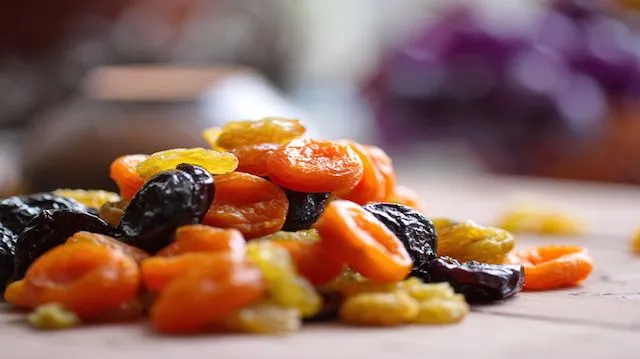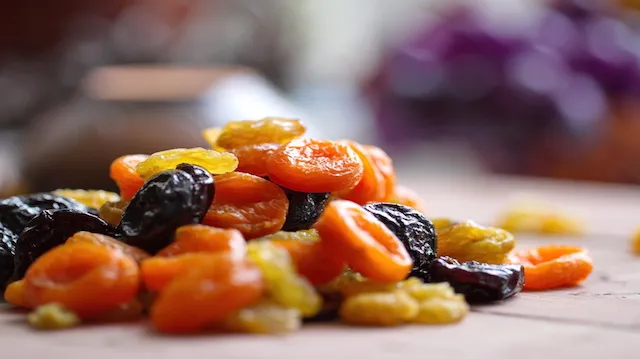
- Share on Facebook50
- Share on Pinterest
- Share on Twitter
Dried fruits sometimes get a bad reputation due to the fact that some have a high concentration of natural sugars, as well as the processing that some varieties go through. While you do have to be careful which ones you choose, and how many you eat, many dried fruits can provide phenomenal benefits for your health.
First, dried fruits are a great alternative to refined and artificial sweeteners in a recipe, and are an even better choice than some natural sweeteners, because they are whole foods. Dried fruit retains the fiber, vitamins, and minerals of the whole fruit, and though you shouldn’t eat too much of it, dried fruit is better for your blood sugar than even some of the “healthiest” liquid sweeteners out there.
Though dried fruit is a natural source of fructose, it’s also packed with fiber, B vitamins, and potassium. Some options are even hidden sources of calcium and iron — which you might not guess at first glance.
Dried fruit goes great in oatmeal, baking recipes, energy bar recipes, and raw snack balls. One or two pieces can be used in a smoothie in place of liquid sweeteners. It’s also a great ingredient in raw trail mix, but do avoid just eating it by the handful, since those natural sugars can add up (and may give you a tummy ache!).
You should also be careful when purchasing dried fruit — they’re definitely not all equal in terms of nutrition. For example, many dried fruits are processed with sulphites (a preservative that can cause an allergic reaction), added sugars, oils, and other potentially dangerous preservatives such as benzoates.
Since fruit is a highly sprayed crop, it’s always best to purchase organic dried fruit to avoid pesticides and chemical agents of all kinds.
These are some of the most antioxidant-rich and fiber-rich dried fruits to choose from:
Black mission figs
Figs are higher in calcium than milk per cup, making them great for your bones and blood pressure. They’re also a great source of Vitamin B6, magnesium, and iron, and are high in soluble fibers, which can help to relieve bloating and constipation in one. Figs are also easy to use in place of dates for less sugar and just as much flavor. Since they’re large like dates, they can also be soaked and used in a one-to-one ratio in any recipe.
Black mission figs are higher in antioxidants than regular Turkish figs; however, all varieties of figs are equal in fiber and other nutrients, such as potassium, magnesium, and iron. If you’ve never tried a fig and wonder what they taste like, figs taste a bit like caramel, and a little like vanilla and raisins combined!
Apricots
 Apricots are a good option if you’re looking for lower sugar content than most types of dried fruits, as well as plenty of antioxidants. Apricots are a great source of vitamin C and fiber, and they’re also a relatively easy dried fruit to digest, since they’re one of the lowest in fructose.
Apricots are a good option if you’re looking for lower sugar content than most types of dried fruits, as well as plenty of antioxidants. Apricots are a great source of vitamin C and fiber, and they’re also a relatively easy dried fruit to digest, since they’re one of the lowest in fructose.
Most apricots are processed with sulfites and added sugars, so find some online if you can’t find any in stores that are organic and free of preservatives. You can use them anywhere you would use larger dried fruits like dates or figs, and they’re especially tasty chopped into muffins, energy bars, and homemade granola bars.
Dried plums
Dried plums, aka prunes, are good for more than just keeping you regular. They’re packed with boron, a mineral needed for healthy, strong bones. Dried plums are also a good source of iron, potassium, and soluble fibers. They are fairly low in sugar compared to dates, they’re quite tasty, and they’re rich in vitamin C too.
Chop dried plums into muffins, bars, and any baked goods, or use them in place of dates in a recipe if you like.
Mulberries
Mulberries are a must-try if you haven’t already! Just one quarter of a cup of these contain over 130 percent of your daily vitamin C needs. Mulberries are also lower in sugar than many other dried fruits. They are a good source of iron, potassium, B vitamins, and magnesium.
These berries look like raisins, and their flavor is a combination of vanilla, figs, raisins, and wine. Look for raw and organic versions as the best option, and enjoy them in place of raisins.
Raisins
If you’re looking for the cheapest option with the most nutrients, stick with the good old raisin. This dried fruit is a nutrition bomb! Raisins are a staple ingredient in many classic dishes. They are great for regularity, bone health, heart health, energy, mood, and even your weight when eaten in moderation.
They can be used for a variety of dishes, but always buy organic, since conventional raisins can contain high levels of pesticides.
Goji berries
Goji berries are a popular superfood not to be missed. Though they’re a bit tougher in texture than raisins, they can be used anywhere you would use raisins. You can soak them in water to soften them if desired. Goji berries are one of the highest sources of antioxidants on the planet, including vitamins A and C.
They’re also filled with fiber, and their tart and sweet flavor will win you over in no time!
All of these dried fruits contain properties for good health; many have even been linked to heart disease and cancer prevention. Rotate which ones you use, and try various varieties until you find your favorites.
It’s always smart to rely mostly on fresh fruits (and even more on vegetables) whenever you can for general health, but don’t avoid dried fruits completely. They’re great as long as you’re mindful of how you use them, and how many you eat.
What’s your favorite way to use dried fruits? Which varieties do you enjoy most?
—The Alternative Daily
Sources:
http://www.medicaldaily.com/apricotnutrition3surprisinghealthbenefitsapricots2466 62
http://healthyeating.sfgate.com/benefitseatingprunes4421.html http://healthyeating.sfgate.com/healthbenefitsdriedapricotsprunes2372.html http://www.whfoods.com/genpage.php?tname=foodspice&dbid=24 http://www.healthline.com/healthslideshow/gojiberryfacts http://www.globalhealingcenter.com/naturalhealth/6healthbenefitsofmulberries
http://www.acc.org/aboutacc/pressreleases/2012/03/25/15/51/raisins_bp
http://www.health.harvard.edu/newsletter_article/beating-high-blood-pressure-with-food
- Share on Facebook50
- Share on Pinterest
- Share on Twitter

